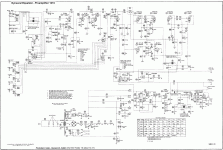What a fascinating schematic. Right off the bat I am very surprised that low mu triodes are the first active devices in the phono section (the selectable eq. circuitry). I would have expected a high gain stage first.
Can someone explain to me what exactly does the Dynaural circuit do in the highlighted area? Reportedly it's for suppressing scratch noise for 78 records. It's certainly a fascinating, complicated, and unconventional circuit. How does it function? Does it also do any compression? My friend has a unit and I even pulled the two 12AU7 tubes, V4 & V5, out of the circuit and did not affect the output. It appears the two tubes are not in series of the signal.


Those 2 circuits ( gates ) act probably like variable electronic capacitors , in combination with L1 would shunt some frequencies to ground , filter supressor for rumble , 6KHz , 12KHz , 20KHz . Pretty useless for what we listen today .
Last edited:
directdriver,
(And others)
In order to hear the difference, you probably need . . .
1. (*) Some old noisy, scratchy, and popping 78 records
An old rumbly turntable and cartridge, and an old phono preamp (the preamp in the Scott 121C).
A CD player with any production CD recorded after the birth of the CD, is not going to have much rumble, pops, and noise to eliminate.
2. (**) So, just ask your friend to take his 78 recordings, turntable, and cartridge, and record some of that on to a CD for you.
Then pop the CD into your player and listen for the effectiveness of the old amplifier circuits.
directdriver, does your friend have either number 1 or number 2?
Please, no more posts until we hear about the results of the correct listening tests.
Everything is what it seems to be, until you find out it is different.
(And others)
In order to hear the difference, you probably need . . .
1. (*) Some old noisy, scratchy, and popping 78 records
An old rumbly turntable and cartridge, and an old phono preamp (the preamp in the Scott 121C).
A CD player with any production CD recorded after the birth of the CD, is not going to have much rumble, pops, and noise to eliminate.
2. (**) So, just ask your friend to take his 78 recordings, turntable, and cartridge, and record some of that on to a CD for you.
Then pop the CD into your player and listen for the effectiveness of the old amplifier circuits.
directdriver, does your friend have either number 1 or number 2?
Please, no more posts until we hear about the results of the correct listening tests.
Everything is what it seems to be, until you find out it is different.
Last edited:
